Don't wanna be here? Send us removal request.
Text

Better read the fine print on those things before you start waving them around.
RULES FOR COMMENTS (because I’m guessing this one will need it):
1. If this feels like a personal attack or makes you want to unfollow, I don’t need to hear about it. You can just go quietly and get on with your day. (You might also take some time to think about whether or not you have some things to unpack.)
2. Please do not bash personality disorders, bipolar disorder, or other forms of neurodivergence by saying those are the “real reasons” these people are shitbags. Throwing other NDs under the bus to get the heat off of Autistic people is not Neurodiversity Paradigm friendly.
3. Please no discussion/arguments about the term “Asperger’s” or “Aspie.” That’s not what this one is about.
4. No, not every person who still uses either of those terms is automatically an Aspie Supremacist or otherwise bad person, so don’t come at me like that’s what I said. There are many reasons why people may still use it, and believing that they are superior to other Autistics and/or all of humankind is only one possibility.
Also, it's okay to just laugh.
145 notes
·
View notes
Text

ND = Neurodivergent, which means anyone with a neurobiology that operates differently from what society has deemed “the norm.” (Social skills classes are most often recommended for autistic people, but not exclusively. So ND is not being used here as a stand in for “autistic” only, but in the most inclusive way possible.)
NT = Neurotypical, which means anyone with a neurobiology that operates comfortably within what society has deemed “the norm” (aka neuronormative culture).
When the people behind teaching social skills to autistic people got the idea, they were operating under the assumption that we simply didn’t have any social skills. Essentially, they thought there were holes in our programming just waiting for someone to insert the missing code that would enable us to run the “regular human” software bug-free.
However, their premise was deeply flawed, because we already have social skills. AUTISTIC social skills. So when they put us in these social skills programs, they’re actually trying to overwrite pre-existing code, not fill in some empty gaps.
Not only does this not feel very good to us, but there’s growing evidence that it’s not even all that effective. Those “skills” rarely ever become as automatic as they want them to be, we often still struggle to find real friendship, and we usually end up with low self esteem and/or social anxiety for our trouble.
Even still, there are some people who struggle to navigate neuronormative ways who would like *some* kind of help with decoding neurotypical social norms. Even if you don’t want to fully replace your own programming with theirs, it might be nice if you could at least understand it, right?
But how do you teach NT social skills without making ND people feel bad about their own set of skills? Can it even be done?
Well the neurotypical people who created the most popular social skills programs out there may not have been able to conceive of such a thing, but yes, it CAN be done - and here’s how.
#autism#autistic#actually autistic#adhd#audhd#neurodivergent#neuro affirming#social skills#autistic social skills
174 notes
·
View notes
Text
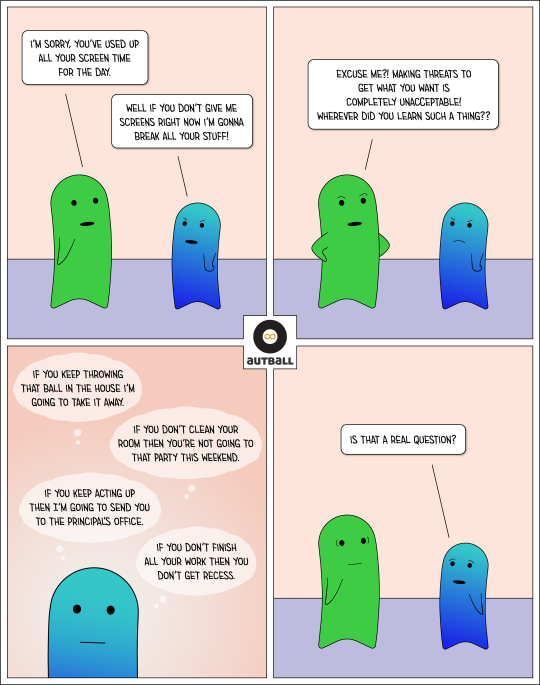
You, all right?! I learned it by watching you!
ETA:
“Are you saying that we should just accept this kind of behavior from a child??” No, I am not.
“Are you saying we can never use any kind of consequence even for safety reasons??” Also no. I myself have to use the one about the ball (and other objects) somewhat frequently. (The other three are kinda bullish!t, though.)
What I AM saying is that if your kid comes at you with something like this, they didn’t get it from nowhere.
They’re not a budding psychopath, this is not a “lack of empathy,” it’s just a simple bit of logic: Adults threaten me with something upsetting in order to get me to do what they want, so I guess that’s what people do to get what they want.
We as adults come up with a whole bunch of reasons why “it’s different when I do it!” We’re the adults, we know better, it’s a health/safety issue, it’s our job, blah blah blah. But when you have a kid who doesn’t see why things like age or status should matter when it comes to who is allowed to do what to whom (which is not uncommon with neurodivergent kids), none of that really matters. What matters is that, from their perspective, you are threatening something painful in order to control them, and they feel it’s only fair to give that right back.
So what are you supposed to do if this happens? First off, don’t panic. Don’t make moral judgments about their character, don’t flash forward to them in prison in ten years, none of that stuff. Remind yourself that they’re just mirroring what they see, and that they can still be guided in a different direction. (Collaborative parenting approaches that don’t rely on consequences are great for this.)
Also remember that, just like most people, they’re not actually able to think clearly when they’re this upset. People who feel out of control start looking for ways to feel in control again (which is why so many adults resort to threatening consequences to get compliance, BTW), and that’s what this is. You can help the situation by learning to de-escalate instead of coming right back at them with even bigger controlling energy.
Some kids will be WAAYYY more influenced by what’s being modeled for them than they ever will be by what they’re told. If you’ve got one of those, make sure you spend some time looking in the mirror and at other things/people they’re exposed to before launching into a lecture on what is and isn’t “acceptable behavior.”
#autism#autistic#actually autistic#adhd#audhd#neurodivergent#pathological demand avoidance#oppositional defiant disorder
404 notes
·
View notes
Text

I know I'm late, but... ❤️
103 notes
·
View notes
Text

Part 5 of a 5 part series about the ways harmful practices are being made to sound more appealing and how to spot the differences between helpful and harmful approaches.
Communication support is a desperately needed thing for so many autistic people and their families. So unlike some of the other things I’ve posted about this week, this is 100% a worthy goal. Unfortunately, many places that claim they can offer it are not delivering.
In some cases, they simply don’t have the education to properly support communication needs (I’m looking at you, ABA). Other times they do have the proper education (ie Speech Language Pathologists) but they will gatekeep certain methods of communication, either because they believe harmful myths about them or they haven’t been trained in that particular method. Also, not every SLP knows about Gestalt Language Processing, so even an otherwise great therapist could be missing some information.
So here are some questions to ask when trying to figure out if someone is truly capable of offering well-rounded, neuro-affirming communication support:
Are they more concerned with making the client easier to deal with for others, or are they focused on the client’s rights, needs, and wishes? (We’re looking for the second one.)
Do they address the client directly, or do they speak as if the client isn’t even in the room? (We’re looking for the first one.)
Do they see speech and language as a behavioral thing? (Verbal Behavior and PECS are dead giveaways - and we want a NO.)
Do they understand that an inability to produce speech has no bearing on a person’s ability to think and feel? (YES✅)
Do they only push for speech, see speech as the end goal, or value speech above all other methods of communication? (NO✅)
Do they honor things like echolalia, pointing to objects, and bringing an adult over to something they want as valid communication? (YES✅)
Do they honor things like refusal to participate, crying, and meltdowns as valid communication? (YES✅)
Do they believe that things like pacifiers, AAC, or responding to “non-functional communication” discourages speech/“functional” communication? (NO✅)
Do they know about Gestalt Language Processing and believe it is a thing? (YES✅)
Do they require “pre-requisites” before they will try alternative communication methods? (NO✅)
Do they require the client to earn time on their AAC device or remove the device when they deem it a distraction, essentially taking away their voice? (NO✅)
Do they know who to send you to if they aren’t personally trained in an approach they think would be more helpful? (YES✅)
Obviously, trying to find someone local to you with all the green flags and no red ones is kind of like trying to find a unicorn for most people. But if you have a choice between two or more therapists, you can at least go with the one who has more right answers and be ready to advocate/educate when needed.
If you literally have only one option available to you and it’s not a good one, you can either be ready to advocate at every turn or just choose not to use their services. Yeah, that’s allowed! Not every autistic person needs speech therapy, and not all communication support has to be directly administered by a professional. You as the parent or caregiver will play a huge role in supporting your person with their communication needs, and luckily there are online resources and virtual trainings that can help you do that.
P.S. What’s the difference between PECS and picture cards, you ask? PECS is a whole ABA-based program that uses a limited set of picture cards and should be avoided for several reasons. Meanwhile, plain old picture cards are something that can be made and used by anyone without any specific program.
P.P.S. Zero debates about the legitimacy of Spelling to Communicate (S2C) or Rapid Prompting Method (RPM) will be entertained (translation - it will be deleted so don’t waste your time).
#autism#autistic#actually autistic#apraxia#nonspeaking#nonverbal#aac#communication is a right#gestalt processing
344 notes
·
View notes
Text

Part 4 of a 5 part series about the ways harmful practices can be made to sound appealing and how to spot the differences between helpful and harmful approaches.
Sensory sensitivities are a huge part of being autistic (and sometimes ADHD, too). They can range from kind of annoying but manageable to debilitating and meltdown-inducing. They can fluctuate from day to day and situation to situation. They can seem to pop up one day out of nowhere and disappear just as quickly.
Sensory differences are dynamic, which can make them unpredictable and disruptive. Not many people want to live that way, so working on sensory desensitization with someone who has a lot of sensitivities sounds like a thing that could help. Fewer meltdowns and able to do more things? Yes please!
But as you might have guessed, there’s a giant problem with that: reducing sensitivity isn’t really a thing you can do TO someone. At least, not without inducing a trauma response or two. You can certainly get someone to learn to ignore their own body signals or pretend to be fine when they’re not, but that’s not a sensory thing. That’s a dissociation thing.
“Sensory desensitization” is usually code for exposure therapy. Exposure therapy has its uses, but addressing legitimate sensory issues isn’t one of them. And it should only be done WITH someone who can fully consent and actively participate. Coercing and/or forcing someone to interact with distressing sensory input until they stop reacting is not that.
“Sensory desensitization” also operates under the assumption that people just get used to, or habituate to, the noises and sensations around them, even ones that bother them. But studies have shown that autistic people actually don’t habituate to sensory stimuli the way non-autistic people do. It may take way longer to happen, or it may never happen at all.
You know what can and does happen? Sensory sensitivities can just kinda…change. All on their own. We grow up, our hormones change, our stress levels change, our environments change, and our sensory profiles are affected by all of those things (and more!). Sensitivities can just disappear, naturally, without any intervention. And that’s about the only thing I’d ever refer to as real sensory desensitization.
But sensory sensitivities can go any which way. Maybe new ones rear their ugly heads. Or maybe something bothers us at a level 7 one day and 2 the next, then goes all the way up to 11 next week. And then there are the ones that just stay pretty much the same, all the time, forever.
I could not handle pants for a long time as a kid, but then somewhere along the way, I could. I really couldn’t tell you when it happened. There are some foods that used to make me gag that no longer do, and there are some that I still just cannot handle. I have never been okay with things that stick to my hands, and that really hasn't changed since as far back as I can remember.
You know what all these sensory sensitivities have in common? Someone made me “tolerate” them at some point, often repeatedly. And none of them changed (or didn’t) because of repeated exposure, but because of my natural development. All I got from forced exposure was this lousy tendency to disconnect from myself.
Sensory desensitization is just not a thing we should be trying to do to people. Sensory *integration* is a real thing that can help people, but that is a whole different animal that requires more than just exposing people to stuff that bothers them. You’ll need an OT (Occupational Therapist) with the specialized training for that. Just make sure they’re not sneaking behaviorism tactics or exposure therapy in there either (yep, the words “sensory integration” can be used to misrepresent what they’re doing, too).
It is a far better thing to help someone learn about their own sensory profile and how to manage their sensory needs than to make them ignore their own body signals. Alexithymia is not #goals.
#actually autistic#autistic#autism#adhd#audhd#sensory processing differences#sensory processing disorder
371 notes
·
View notes
Text
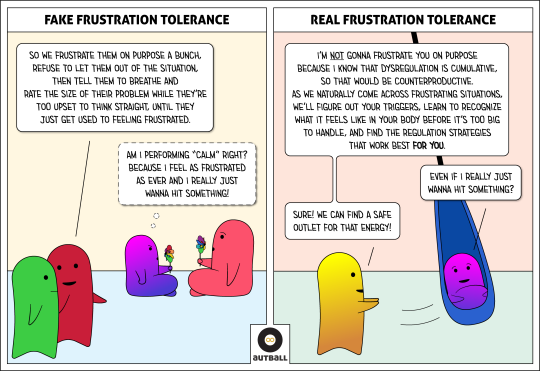
A kind of subset of self-regulation skills (which I posted about yesterday) is frustration tolerance. It’s another popular recommendation for ND kids that *sounds* like a very worthwhile goal. If your kid is frustrated and acting out all the time, getting them to tolerate frustration better sure seems like it would solve a lot of problems.
Here’s the thing about that: you don’t get better at feeling frustrated by spending more time being frustrated. You just get more fucking frustrated. And just like with the attempts to “teach” self-regulation skills, all you’re gonna get is someone who gets better at *pretending* not to be frustrated OR someone who lashes out more because you won’t stop frustrating the shit out of them.
Being “easily frustrated” is a problem, yes. But what you’re really looking for isn’t frustration tolerance, it’s frustration *management.* And that is a team effort, not solely the responsibility of the person who’s always feeling frustrated.
#autism#autistic#actually autistic#adhd#audhd#neurodivergent#pathological demand avoidance#frustration
630 notes
·
View notes
Text
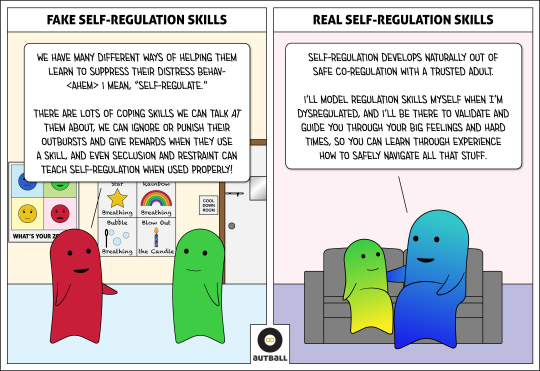
Part 2 of a 5 part series about the ways harmful practices can be made to sound more appealing and how to spot the differences between helpful and harmful approaches. Self-regulation skills for kids are all the rage right now, and there are lots of people who will tell you that they have just the program for that. Which sounds awesome, right? Self-regulation is great! Who wouldn’t want that for their kid who is just so upset all the time?
The problem is that these people think self-regulation is just a set of skills you can teach someone. Or even better, that if you ignore a person in distress long enough, they’ll magically come up with those skills on their own. (Like, what even is that logic? Oh right, it’s the same thinking that makes people believe the Cry It Out method for babies is a good idea.)
But that’s not how that works. Self-regulation skills come from safe co-regulation, and the learning begins in infancy. Then it takes YEARS of more co-regulation and brain development to get to a place where a person can even start to recognize the need for and use those skills of their own volition.
Oh, and they also have to have enough time NOT in distress to even know what it feels like to feel safe and regulated in the first place. They need room to develop said self-regulation skills. You can’t just keep a kid in a pressure cooker all the time and expect them to learn how to “regulate” through it (which is exactly what many people are doing to the autistic and ADHD kids they put through these programs).
When you try to teach self-regulation skills to a stressed out, traumatized child without doing ANYTHING to make their environment safer and less demanding, or doing ANYTHING to make yourself a safe co-regulator, the most you can hope for is that your child gets good at *acting* calm and *performing* regulation skills (and that’s if it doesn’t just backfire completely). But the inner turmoil is still there, and they still have no idea how to deal with it.
And kids who are left alone in their distress don’t “develop skills.” At least not any healthy ones. They just keep crying or lashing out until they can’t anymore, and they learn that no one cares to help them in their darkest moments. If you do it long enough, you might even push them into shutdown or fawn mode, which is super convenient for the adults, but devastating for the child. For the record, breathing exercises are not inherently bad. Neither is learning to recognize body sensations or what “zone” you’re in or any of the other things that can help with self-awareness (as long as we’re not sending the message that certain feelings are “good” or “bad”). It’s just that those things don’t work for everyone, and they’re not a substitute for safety and co-regulation.
Kids need safe adults, and they need to be around them more for than just an hour or two a week in therapy session. It’s the *caregivers* who need to learn *co-regulation skills,* not the children who need to learn self-regulation skills. It’s the *adults* who need to de-stress the child’s life, not the child who needs to learn how to handle overwhelming amounts of stress better. And it’s the *adult’s* job to nurture self-regulation, not a child’s job to try and figure it out on their own.
(There’s even more to self-regulation than this, of course, like the sensory processing element and the fact that being regulated is not just about being “calm,” and I’ll touch more on those in tomorrow’s post about Frustration Tolerance.)
I learned most of what I know about how children develop self-regulation through co-regulation from Mona Delahooke, and I highly recommend her work if you want to learn more about it. Trauma Geek also has information on how to find felt safety as an adult if you didn't get enough co-regulation growing up. https://www.traumageek.com/blog/3-foundational-truths-about-nervous-system-science
P.S. Did you know you can co-regulate with animals, too, or even a tree?! They might not be the greatest at modeling skills or validating your feelings, but they can still contribute to felt safety.
189 notes
·
View notes
Text

Part 1 of a 5 part series about the ways harmful practices are being made to sound more appealing through the co-opting of language and how to spot the differences between helpful and harmful approaches.
The language of the Neurodiversity Paradigm is soooo hot right now. Everyone from ABA centers to social media creators are adopting it to sound like they’re safer and more knowledgeable than they are.
But you can’t just pop some neuro-word in place of “autism” and stop picking on a couple of Autistic traits and call yourself “Neuro-affirming.” That’s the low-hanging fruit of #neurodiversitylite.
REAL Neuro-affirming practice comes from a complete shift in mindset, unlearning all the harmful things you once thought were true, and learning about all the things you never even knew you didn’t know. It’s also an ongoing process, not just something you can learn from reading an article or taking a single training.
ABA practitioners are probably the worst offenders right now, mainly because they know they need to rebrand as more and more people learn about what ABA really does to people, but also because their practices in particular are THE furthest away from being Neuro-affirming compared to any other discipline.
They are not the only ones, though, so be wary of #neurodiversitylite in ANY resource aimed at autistic people that appears to be saying all the right things, including: OT, speech, play/talk therapy, early intervention, education, your favorite parenting expert or social media personality who just discovered the world of Neurodiversity, etc.
Look beyond someone’s use of the “right” words or symbols. Do they talk about teaching people to fit into the normative world, or how to more safely and authentically navigate a world not made for them? Do they talk about making the person easier to deal with, or making life easier for the person? Do they concentrate on external behaviors, or are they more concerned with internal experiences? Does most of what they know come from people who studied autistic people from the outside looking in, or from actual autistic people who can speak from lived experience? And are they even using the words right??
The good news is that there are SO MANY resources out there BY autistic and otherwise Neurodivergent people for anyone who wants to learn how to make their practice *actually* more Neuro-affirming. SO MANY!! Three such resources are featured in the second panel from Autism Level UP, Neurowild, and Kieran Rose-The Autistic Advocate. (Big thanks to them for letting me include their work in the cartoon!)
EXPLANATION OF WHAT’S WRONG IN THE “FAKE” PANEL:
- The phrase “individuals with neurodiversity” misuses the word “neurodiversity” and utilizes person first language. The Neuro-affirming phrase would be “neurodivergent people,” or “autistic people” if they specifically meant autistic people.
- Getting rid of puzzle piece stuff is merely a surface level first step, not an end point.
- Not forcing eye contact and allowing hand-flapping are also only surface level first steps. The fact that they still target other stims means they do not understand the importance or functions of stimming, making them incapable of being Neuro-affirming.
- Social skills training aimed at ND people usually centers NT social skills as the “right way” and frames ND social skills as the “wrong way,” making them shame inducing and not at all affirming.
- “Tolerating distress” most often means “suppressing distress.” Neuro-affirming practice would concentrate on identifying and avoiding triggers, helping the person stay regulated, and teaching the person how to accommodate and advocate for their needs so that they are not distressed in the first place.
- “Sensory desensitization” is not a thing that can be done to someone without harm. It is usually done with exposure therapy, which should not be done TO someone who cannot consent. It is also inappropriate for sensory issues, which tells us they don’t understand sensory processing differences at all.
- The posters: Whole Body Listening is based on neuronormative expectations; “They say I’m neurodiverse” is incorrect usage of the word “neurodiverse” (it should be “neurodivergent”), and “but I say I’m perfect” insinuates that being “neurodiverse” is a bad thing, while the use of the rainbow infinity symbol with such a non-affirming message adds to the dissonance; the ABC’s of Behavior is an indicator that ABA/behaviorism will be used, which is the opposite of Neuro-affirming practice.
EXPLANATION OF WHAT’S RIGHT IN THE “REAL” PANEL:
- The person accurately explains what Neuro-affirming practice looks like, without needing to use (or misuse) any Neurodiversity “buzzwords.”
- Bumper, A Whole Body Learner, is a resource created by Autism Level UP that encourages people to discover what it looks like for them to be ready to learn, acknowledging that there is no one right way to appear attentive.
- The poster by Neurowild indicates that they value difference and neurodiversity and that they know there is no one right way of being.
- They use the Advoc8 Framework, a resource created by Kieran Rose, The Autistic Advocate. Using this framework means they want to help the people they work with achieve Agency, Autonomy, (Self) Acceptance, and Authenticity.
320 notes
·
View notes
Text
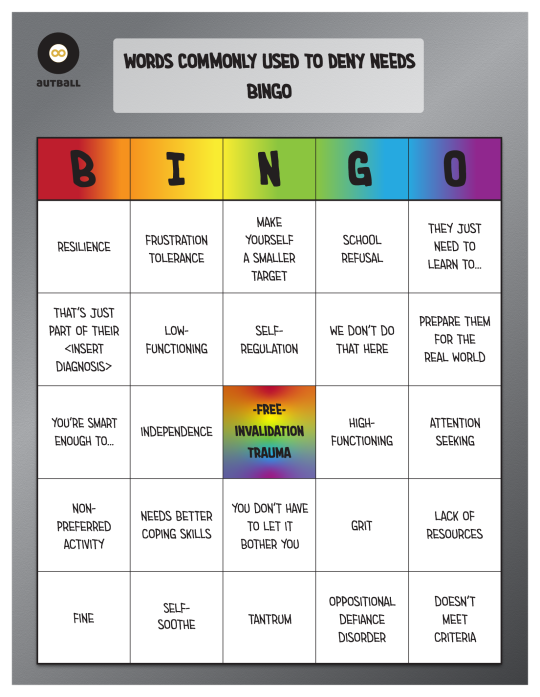
It starts early. Doctors and others will say to ignore a baby's cries so they can learn to "self soothe." And it continues all the way through school, then into the workplace, and can even carry over into personal relationships. Hell, a lot of us hear it so much we end up doing it to ourselves:
The denial of other people's needs in order to avoid being inconvenienced by them.
We want to start early by making babies more convenient, so that the children are more convenient for the teachers, and then the adults are more convenient for the employers and society at large.
This is just the way much of the world works; everyone will have their needs denied for the sake of convenience at some point. But autistic, ADHD, and otherwise disabled people will experience this at every turn because so many of our needs are not met by the status quo.
Which means schools and workplaces and service providers and more have gotten really creative with all the ways they can deny we even have a need in the first place. 'Cause if they admit there's a need, they might have to <gasp> DO something about it. And we simply can't have that.
So here are some of the many coded words/phrases that someone might use to deny the presence of needs so as not to be inconvenienced by them. How many have you heard?
#actually autistic#autistic#autism#autistic experiences#autistic problems#adhd#audhd#disability#disabled#neurodivergent
423 notes
·
View notes
Text
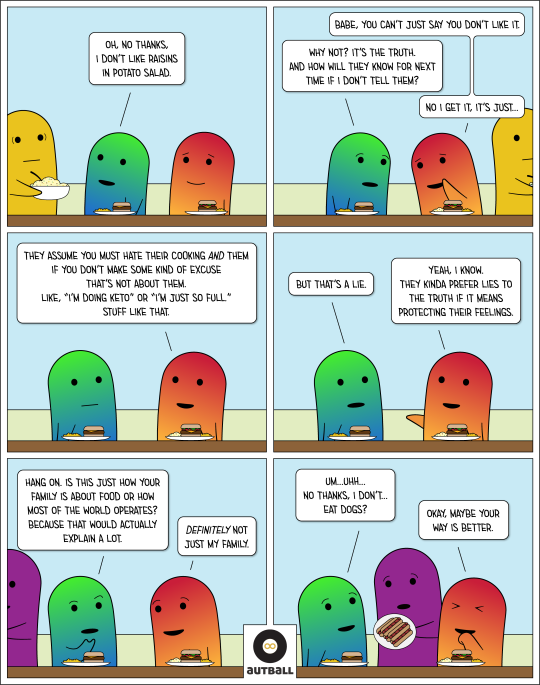
The truth shall…get you in trouble a lot of the time.
574 notes
·
View notes
Text
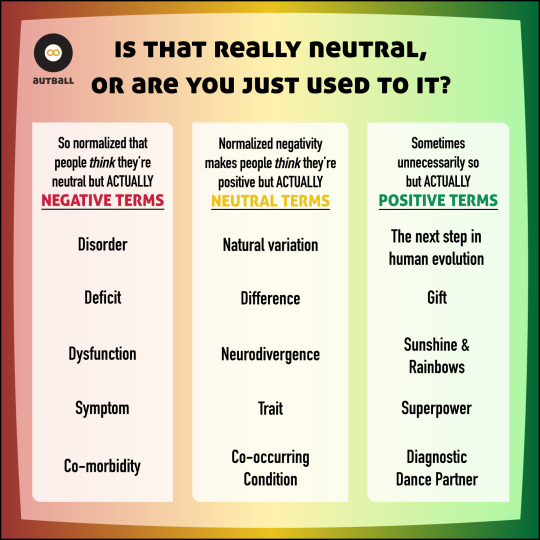
Autism as a concept has lived in the pathology paradigm from the very beginning. That’s about a hundred years of seeing Autistic people as “broken” and in need of fixing. It is officially diagnosed as a “disorder,” and the diagnostic criteria are full of pathologizing language. So for most of society, negative language and attitudes around autism are “normal.”
To someone in the medical or mental health field, pathologizing language is also “normal.” Same goes for people in education, particularly special education. It’s just how they talk about patients and students, they don’t mean anything by it, you HAVE to talk about a person’s deficits/symptoms in order to get them help. It’s just…normal.
But sometimes, when something negative is normalized enough, people can mistake it for being “neutral.” Which leads to people arguing that the word “disorder” is neutral, and that the actually neutral language of neurodiversity is “overly positive.”
That’s all incorrect, though. The word “disorder” is not and was never intended to be neutral. The language used to diagnose autism as a medical/mental health condition is not and never has been neutral. And “normalized” is not the same as “neutral.”
And so, here’s a handy dandy (and slightly snarky) graphic for anyone out there whose frame of reference could use some re-centering.
NOTE: Genuine questions are fine. Attempts to argue that pathologizing medical language is neutral OR that autism is a disorder are not. If you are uncomfortable in the realization that the language you’ve been using contributes to negative attitudes towards Autistic people, that’s a sign that you have some stuff to learn, not an invitation to get defensive in my comments section.
ALSO NOTE: Nowhere have I told anyone how to refer to or think of *themselves,* so don’t come at me with that one either.
ALSO ALSO NOTE: I don’t actually endorse anything in the “positive” column either. It is strictly to demonstrate that there is a difference between neutral and positive language, and all of it is meant tongue-in-cheek. Toxic positivity and supremacy don’t help anyone.
#autistic#actually autistic#autism#autism acceptance#neurodiversity#neurodiversity paradigm#paradigm shift
187 notes
·
View notes
Text




Expanding a bit on last week's post.
#autism#autistic#actually autistic#autistic experiences#disability#autism is a disability#disabled is not a dirty word
424 notes
·
View notes
Text

There seems to be some confusion out there. Hope this helps. 😉
#autism#autistic#actually autistic#autism acceptance#autism is a disability#disabled is not a dirty word
379 notes
·
View notes
Text

I saw a funny post by @emergentdivergence and just HAD to do something with it.
I’m sure most of my followers at least will be just fine. 😉
[Image description:
A 4 panel cartoon by Autball, done in collaboration with David Gray-Hammond.
1: A Red/Purple figure with gray glasses and a lip ring says, “April is Autism Acceptance Month, and you know what that means…”
2: A bunch of NT and ND figures stand all together (some looking happy, some looking not bothered, and some looking quite bothered indeed) while Red/Purple continues offscreen with, “Anyone not accepted by an Autistic person before April 30th will be yeeted into the sun.”
3: Close up of Red/Purple who says, “But don’t worry…”
4: Red/Purple continues, “We’ll only make you work as hard for our acceptance as we’ve had to work for yours.” To the left is a yellow/gold figure holding three heavy books entitled Autistic Communication, Unlearning Ableism, and Masking. To the right is a light blue/blue figure holding three more heavy books entitled Stimming, Autistic Social Skills, and Neurodiversity 101.]
2K notes
·
View notes
Text
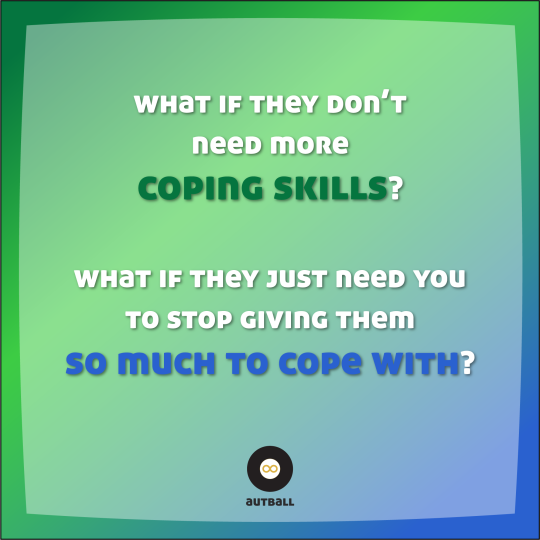
A child is having outbursts at school, or at home, or wherever else, on a pretty regular basis. And at some point, someone suggests that they need to learn better coping skills.
They suggest therapy, or maybe there’s even a special program at school. Because yes, better coping skills/self-regulation skills/frustration tolerance really would solve everything, wouldn’t it?
Well those are fine skills to have, to be sure, but more often than not, it’s not what that child (or adult) needs most. What they really need is someone to figure out what’s stressing them out so much and then do something about THAT.
Because it’s not actually weird to be distressed over distressing things. Maybe *you* don’t understand what’s so distressing about school or the grocery store or that new person in the house, but that doesn’t mean *their* distress isn’t legit.
People reeaalllly like to suggest better coping skills for autistic, ADHD, and otherwise ND folks. (Since we already have a diagnosis, it’s that much easier to locate the problem in US.) And what they’re really saying with this an awful lot of the time is, “Can you please stop being so distressed by distressing things because it’s making a lot of work for us and we’re not about to change anything for you.”
So before you put someone in some sort of therapy that will teach them that they’re wrong to be upset about the things that upset them and how to get better at pretending to be okay, maybe consider that you might be expecting them to “cope” with more than they can reasonably be expected to.
#autism#autistic#actually autistic#autistic problems#autistic experiences#adhd#audhd#pda autism#pathological demand avoidance#neurodivergence#coping skills
1K notes
·
View notes
